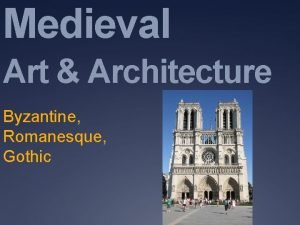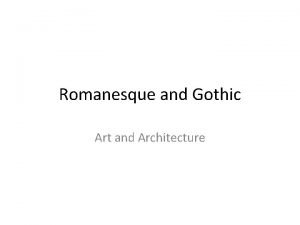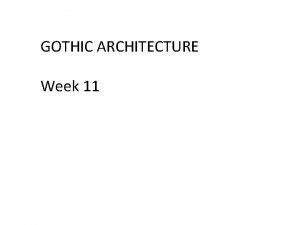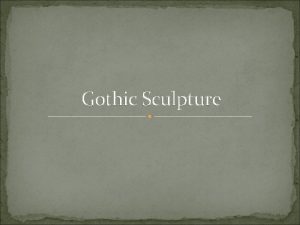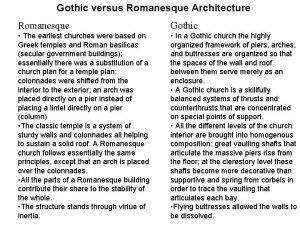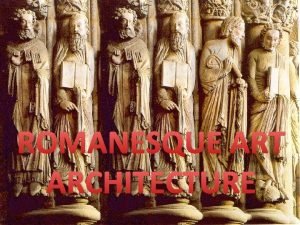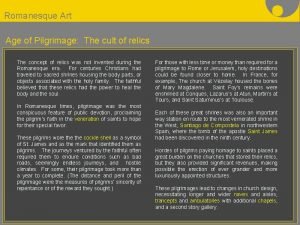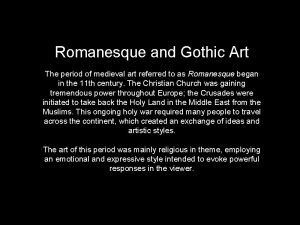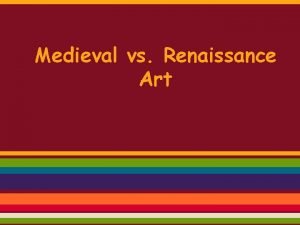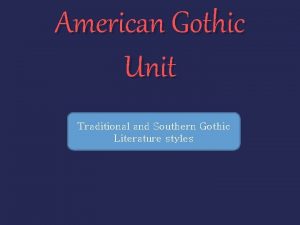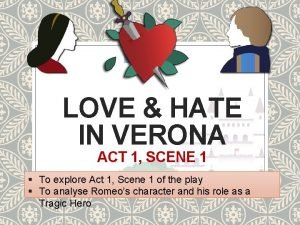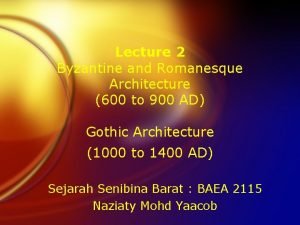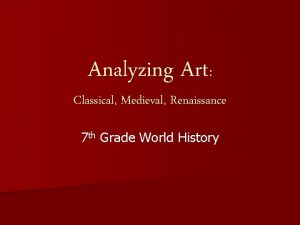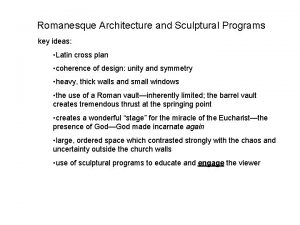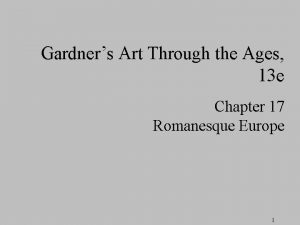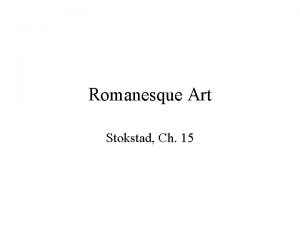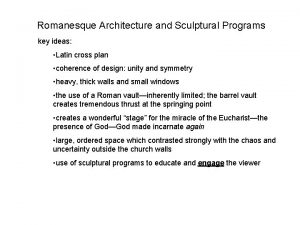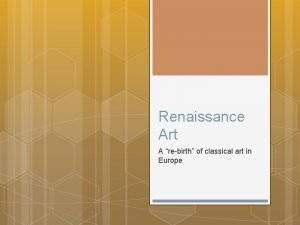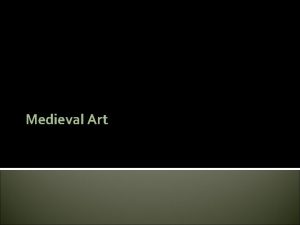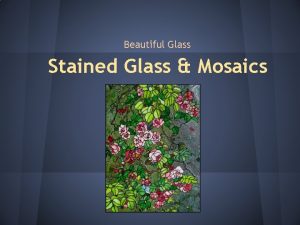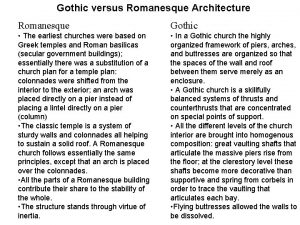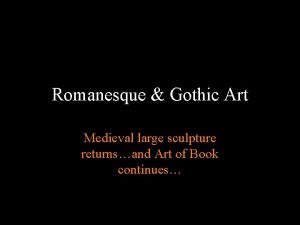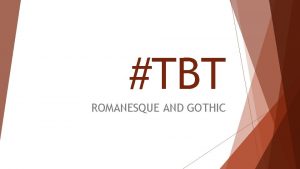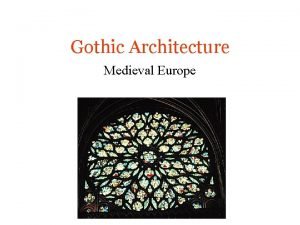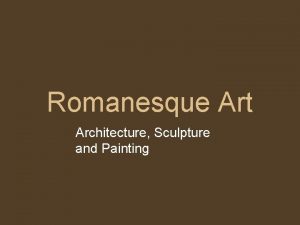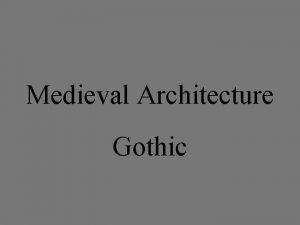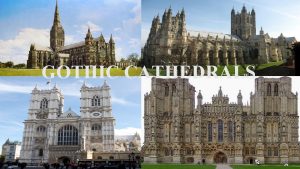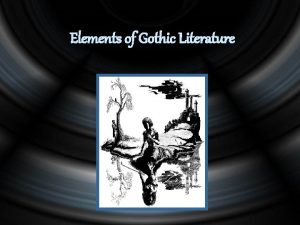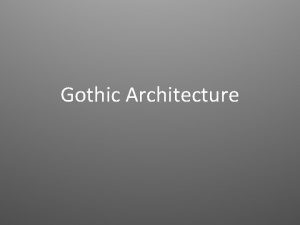Stained Glass Medieval Art Romanesque and Gothic Art































- Slides: 31

Stained Glass: Medieval Art, Romanesque, and Gothic Art Visual Art I, 2013

Early Medieval Art Vocabulary • Illumination: colored illustrations, often containing gold and silver, that decorated manuscripts during the Early Middle Ages. • Vellum: a fine parchment made from calfskin and used for writing, manuscript illumination and book binding.

Early Medieval Art • The Middle Ages refers to a time period that spans over 1000 years. After the fall of the Roman empire, Europe was mostly inhabited by large migrating tribes. Most artwork from this early migration period (400600) is in the form of portable object like ornaments, weapons, and objects of daily use. Animal motifs were also common in decoration and design due to pagan tradition that remained in the largely Christian society. Manuscript illumination was an important art form during this time because it allowed missionaries to spread the gospel through books that were easy to read and carry. These manuscripts were usually drawn by monks in secluded monasteries throughout Europe.

Illumination • Landisfarne Gospel Book (698 -721), this manuscript is made from a superior type of parchment (bleached animal skin) called vellum. The page shown here is the beginning of the gospel of St. Matthew. The illustration is beautifully integlated with abstract and geometric designs of minute detail.

Priest, Knight, Peasant The British Library, London

August from the Hours of the Duke of Berry Limbourg Brothers (1370 -801416)

Battle of Hastings Detail of the Bayeux Tapestry, c. 1073 -83.

Life of St. Hedwig of Silesia Early Christian Art was largely symbolic as the artist did not know how to use perspective , and or anatomy until later in the early 1500’s

Romanesque Art • This term applies to the eleventh and twelfth centuries (1050 -1200). This period of art history is greatly characterized by religious fervor. Pilgrimages to religious sites and the Crusades move immense numbers of people back and forth across Europe, which resulted in a mingling of cultures and goods. Building campaigns were undertaken all of Europe toward building churches, carving sculpture, and decorating them. Thus this period of art greatly reflects the religious enthusiasm that characterized Medieval life during this time.

Romanesque Art Vocabulary • • • Tympanum: a carved or decorated space over the door and under the arch of a Romanesque of gothic church façade. Narthex: a porch of vestibule, sometimes enclosed, preceding the main entrance of a church Mandorla: an almond-shaped outline enclosing the full figure of a person endowed with divine light, usually Christ. Crossings: the area of a church where the transept intersects the nave. Sometimes a dome of tower is built over this area, further emphasizing it as the focal area of the worship space. Ambulatory: any passageway around a central space. A place for walking around the apse of a church, often a continuation of the side aisles, or a covered walkway around the cloisters. Buttresses: a massive support built against a wall to receive the lateral thrust exerted by a vault, roof or arch. Abbey: a complex of buildings comprised by a monastery and a church. Cloister: a covered walkway or ambulatory around an open court or garden. Cathedra: the chair or throne of a bishop. Campanile: a bell tower either attached to a church or free standing nearby.

Detail from Chartres Cathedral

The Mission of the Apostles (1120 -1132) Tympanum of the central portal of the narthex. The title of this relief refers to the Christian belief that the apostles and all the faithful are obligated to spread the Gospel to all nations.

Common Vaulting System Wooden roofs of previous ages were replaced by masonry barrel vaults. These vaults eliminated the danger of fire and produced better acoustics. These Vaults, similar to those used by the Romans, were extremely heavy and required the support of buttresses.

Diagram of Sainte-Sernin, Toulouse, France. This structure was a pilgrimage church. That is, it was built to hold multitudes of travelers on their way to sacred shrines. A large apse and ambulatory, many small chapels, and double side aisles helped control the crowds that moved through the church.

Pilgrimage Roads • During the Middle Ages, Christians in search of salvation made pilgrimages to important shrines. A pilgrimage could mean a dangerous trip of hundreds, even thousands of miles. Pilgrims traveled to churches to see the relics, or remnants of a saint’s clothing, hair, or bones which they believed had the power to cure disease, forgive sins, and perform miracles. Like tourist centers today, people in the various towns where shrines were located made their living from tourist trade selling souvenirs and fake relics to weary pilgrims.

Notre Dame la Grande (1162 -1271) In Poitiers, France this church is a low and wide structure. The barrel vaulted interior has small windows, and is heavy and dark. The exterior has more sculpture than many Romanesque churches.

Giselbertus, The Last Judgments (1130) This carving in the church of St. Lazare at Autun, is a landmark of Romanesque sculpture. It depicts the moment at the end of the world when Christians believe all of humankind will rise from the dead; each to be judged worthy of Heaven or sentenced to Hell.

Gothic Art • This period in art history spans throughout the twelfth and thirteenth centuries during a time of massive population shift in Europe. • Gothic was first used as a term of ridicule by Renaissance critics because the style did not conform to the standards of Classical Greece and Rome. Today Gothic art is synonymous with the new energy and dynamic style of the period. • Cities grew during the Gothic period and cathedral building flourished • The church became the most important influence in art and daily life • Unity is the key concept in Gothic architecture

Gothic Art Vocabulary • Flying buttress: a supportive structure consisting of a tower buttress and a flying arch which spans the side aisles and supports the upper wall of the nave of a Gothic church. • Clerestory: the upper section of a wall (windowed or open) used for fighting and ventilation; also, the upper story of the nave of a church building. • Rose window: a circular window with stone tracery radiating from the center and a characteristic feature of Gothic church architecture. • Tracery: ornamental stonework in a decorative pattern with a lacelike effect; a decorative interlacing of lines suggestive of such stonework. • Fan vaulting: a complex vault with radiating ribs, characteristic of late English Gothic (perpendicular) architecture. • Cartoon: a full scale drawing from which a painting or fresco is made.

Chartres Cathedral, 1194, France One of the best remaining examples of Gothic construction. The basic design is unified, indicating that is was designed by one master builder. Thought the construction proceeded through four centuries and was never completely finished.

Interior view of Chartres Cathedral: a good example of flying buttresses which eliminated the need for heavy Romanesque walls.

Abbot Suger (c. 1081 – 13 January 1151) • He was one of the last Frankish abbot-statesmen, a historian, and the influential first patron of Gothic architecture. • Abbot Suger, friend and confidant of the French Kings, Louis VI and Louis VII, decided in about 1137, to rebuild the great Church of Saint-Denis, the site of Coronation of the French monarch since 754. It is often cited as the first building in the Gothic style. • Suger wished to construct a church that was as beautiful and richly decorated as possible because anything less would be unsuitable for God’s house. His main concern was light because it symbolized the presence of God.

Notre Dame (exterior), began in 1163 Notre Dame is considered one of the best known of all Gothic cathedrals. Looking at the exterior view one can see how it is possible for flying buttresses and other elements of Gothic architecture able to support this huge stone structure while still allowing the space to be open and well lit.

West façade, Cathedral of Reims, 1225 -1229 In this cathedral solidity and heaviness have been replaced by openings and lightness. The towers and not solid but are made up of carved stone tracery.

Example of fan Vaulting, Wells Cathedral, early 14 th century England Here small clustered columns seems to be transformed into ribs for the vault and create a feature called fan vaulting. The vaulting was so elaborate that the style was alter referred to as Flamboyant Gothic.

Examples of Stained Glass from Medieval to Modern

Detail of a medieval window at Troyes Cathedral, France (1300 s)

Contemporary Stained Glass Window

Duke Chapel Stained Glass

Tiffany Glass Lamp, 1902

Tiffany Stained Glass Window, 1905 One of eleven Tiffany windows at Brown Memorial Presbyterian Church in Baltimore, Maryland. It has 58 panels and is thought to be one of the largest Tiffany Studios windows
 Function of medieval art byzantine romanesque gothic
Function of medieval art byzantine romanesque gothic Bile stained and non bile stained
Bile stained and non bile stained Romanesque and gothic art
Romanesque and gothic art Chagall stained glass chicago
Chagall stained glass chicago Gothic structure
Gothic structure Gothic sculpture vs romanesque sculpture
Gothic sculpture vs romanesque sculpture Romanesque vs gothic architecture
Romanesque vs gothic architecture Barrel vault romanesque
Barrel vault romanesque Romanesque period art
Romanesque period art Pilgrimage churches romanesque
Pilgrimage churches romanesque Notre dame la grande france artistic elements
Notre dame la grande france artistic elements Renaissance art vs medieval art
Renaissance art vs medieval art Medieval art vs renaissance art
Medieval art vs renaissance art American gothic literature definition
American gothic literature definition Spools of suffering
Spools of suffering Chapter 29 section 1 marching toward war
Chapter 29 section 1 marching toward war Meconium staining
Meconium staining Stained cheek cell
Stained cheek cell Chapter 3 cells and tissues
Chapter 3 cells and tissues Neighbour stained steel
Neighbour stained steel Enterobius vermicularis genus
Enterobius vermicularis genus What is the glass escalator
What is the glass escalator If acid is splashed on your skin, wash at once with *
If acid is splashed on your skin, wash at once with * Does hot glass look like cold glass
Does hot glass look like cold glass Romanesque byzantine architecture
Romanesque byzantine architecture Classical medieval and renaissance art
Classical medieval and renaissance art Church of sainte foy floor plan
Church of sainte foy floor plan Gislebertus last judgment
Gislebertus last judgment Romanesque pronunciation
Romanesque pronunciation Abbey church of sainte foy
Abbey church of sainte foy Classical art renaissance
Classical art renaissance Characteristic of medieval art
Characteristic of medieval art
